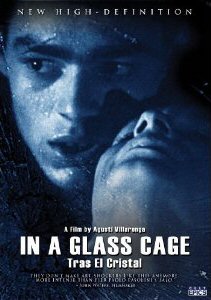
Augusti Villaronga is a little known, yet unique, Spanish film director. He is not one to churn out movies for the sake of it. Instead, he clearly prefers to concentrate on projects that resonate personally with him even if it does mean going up to seven years without work.
This month sees his 1987 feature debut, IN A GLASS CAGE (Tras El Cristal) released through Cult Epics on a special edition DVD. If horror comedies are your thing, you may want to look away now...
The story revolves around Klaus (the late Gunter Meisner), an ex-Nazi, whose war time experiments involving young boys gave him the dubious, self-sanctioned licence to sexually abuse his adolescent subjects. Now living a clandestine existence in Spain, Klaus cannot resist his degenerate lusts. When these erupt into extreme guilt, he looks to take his own life. But he is dealt a fate worse than death. His failed suicide attempt leaves him paralysed and thus relies on a coffin like iron lung and his indignant wife Griselda (Marisa Paredes) to merely exist. Caught up in the middle of this is Klaus’s teenage daughter, Rena. But things are about to change.
A handsome male nurse called Angelo (David Sust) enters the fray. Although Griselda does not approve, Klaus is adamant Angelo should stay and tend to him. After befriending Rena, the bizarre arrangement then starts to turn sinister when Angelo discloses to Klaus he is in possession of his explicit diaries from the war. With Klaus now at the mercy of the enigmatic stranger, the combined desires of the two men start to have devastating consequences...
I think it’s fair to say we are dealing with extremely bleak subject matter here folks! As suggested earlier, Senor Villaronga is synonymous precarious projects. Indeed in an interview included in the ‘extras’ section, Villaronga reveals he simply doesn’t believe he could make a film like IN A GLASS CAGE in 2011. A screening in Berlin even had some patrons baying for his blood, knowing he was in the vicinity! Combining topics such as Nazi experiments and child molestation is hardly an uplifting endeavour. So why should you watch this movie? Well to start with, although it is grim and uncompromising, it has been majestically shot to the point it is quite mesmerising. Starting with the look of the picture, there is a notable effort made to flood the screen with greys and blues. It gives the film a really cold feel and makes the odd flash of opulent colour onto the screen all the more striking. And I am not talking just rudimentary gore here. The detachment of characters, as Angelo works his way into the family, is brilliantly symbolized with the austere use of colouring within the film. There is also a real uncomfortable intelligence used within the 2 hour picture. For example, the facade of a Nazi doctor experimenting on young lads is obviously one of perceived evil. But so clever is the psychology of Villaronga’s film that the viewer is enticed to actually feel sympathy for the vulnerable Klaus, especially toward the finale.
There is no attempt to sensationalize the subject either. From the sombre opening title sequence, augmented with some chilling real life shots of concentration camp atrocities, the viewer is abruptly alerted to the tone of the movie at hand.
Strong performances, as you would expect, are crucial to such a venture, and the cast deliver admirably. The constant wheeze of the encasing breathing apparatus that accompanies Klaus’s onscreen presence helps create a truly asphyxiating atmosphere. The German actor, Gunter Meisner, who plays Klaus (now sadly deceased) initially refused the Spanish written script on the grounds it was too brutal. However, after a more fluent translation, Meisner thankfully changed his mind and turned in a thoroughly committed performance. Although the UK viewer has subtitles, I was still intrigued to hear in a featurette included on the second disc, the lengths gone to in order to create seamless dubbing into Spanish.
The feature itself is a newly restored High-Definition transfer in 1.85:1 anamorphic widescreen and, as a result, the print is very crisp. This sharpness really makes the darker scenes of the film effortless to watch. The options of DTS 5.1 surround and 2.0 stereo are also available.
Also included on the bonus disc are Villaronga’s preceding projects – three short films. All sourced from VHS masters the quality is obviously a little below par, but as the distributors rightfully point out, the rarity of these movies supersede this issue. Again it showcases the Catalan director’s vision of flirting with controversy including religious imagery.
While this may not be for everyone, it is undoubtedly an intelligent and hard hitting psychological horror movie. Who said great art should always be comfortable...?
Review by Marc Lissenburg
| Released by Cult Epics |
| Region 1 - NTSC |
| Not Rated |
| Extras : |
| see main review |